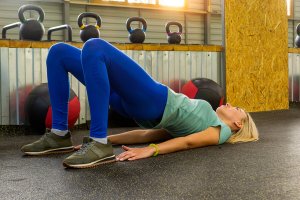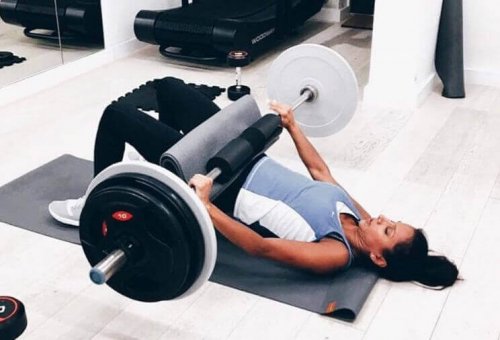The Hip Thrust: One of the Best Exercises for Your Glutes

If you want to have firm and strong glutes, it’s essential that you perform certain exercises. The hip thrust is valuable if you want to achieve this. This exercise requires strategy and technique since it’s not low-intensity; errors have risks because they can lead to serious injuries.
You might like: Develop Your Glutes Quickly with 5 Essential Exercises
Strategy for starting the hip thrust
Although this is a seemingly simple routine, you must proceed with caution. It’s recommended that beginners start with the classic glute bridge, an exercise you should be able to do before attempting the hip thrust. The classic glute bridge works the lower back muscles down to the upper part of the legs.
This exercise consists of raising the pelvis up off the ground. It’s an exercise that some primary school teachers teach their students, as it allows them to learn to align the pelvis with the hip, as well as give them stability and steadiness.
Glute bridge, step by step
To start this routine, lie on your back with your legs bent and your feet firmly on the ground. Place your arms on each side of your torso, with the palms of your hands touching the floor.
Next, tighten your glute muscles and inhale while raising your hips at the same time, pushing off from the floor with the heels of your feet. Hold this position for a few seconds and then lower very slowly while exhaling.
As you lower your hips, keep your glutes tightened and don’t touch the floor. This way, you’ll continue raising your hips until you complete the entire routine. It’s advisable to do two to three sets of 10 repetitions.
Once you’ve mastered this exercise (which can also serve as a warm-up for the advanced), it’s time for the next step: the unweighted hip thrust.
This method allows for lumbar and hip extension, activating the buttock muscles, and favoring pelvic stability. Then, as you advance, you can add weight to increase the difficulty level and improve lower body strength.
Methods and mistakes to avoid with the hip thrust
The routine is as follows: support your upper back on a bench with your knees bent at 90 degrees and your feet placed firmly on the floor. The middle part of your torso should be suspended in the air so that you can raise and lower your hips freely.
Inhale as you lift your hips until your trunk is parallel to the floor and your back is aligned with your pelvis. As with the glute bridge, the momentum should come from your heels and the contraction of your buttocks.
Avoid using your thigh muscles, as the exercise focuses on the lower part of your torso. In the same way, this movement should not be done in an uncontrolled way, so keep your movements steady and well-controlled.
Finally, you should exhale while lowering your body slowly. It’s important to feel how the maximum extension of the hips corresponds to a greater contraction of the glute muscles. Don’t make the mistake of overextending the hips and allowing the back to arch, when in fact it must be straight.
You might like: How to Perfect the Overhead Barbell Squat
Next level
When you’ve mastered this technique, you may start using a bar on top of your pelvis. Hold the bar in your hands, but only to make sure it doesn’t fall on you.
As your muscle strength increases, you may gradually add weight. All routines should be done for three sets of eight to twelve repetitions. Nevertheless, you can add more sets as you acquire more muscle strength and tone.

Reasons to exercise the glutes
The glutes are one of the largest muscles in the body and are located in the center of it. The main function of the glutes is associated with the lower trunk and is mainly related to the stability of the hips.
Additionally, these muscles also intervene in the musculoskeletal structure of the legs; they’re actually responsible for the forward momentum when walking and running.
In our daily lives, our buttocks are able to support a lot of weight and are very important for keeping the spine and back healthy. When you don’t have enough glute strength and tone, this work falls onto other parts of the body in order to compensate.
For these reasons, lack of exercise and adequate toning of the buttocks will inevitably contribute to health problems. This is more than a good enough reason to start exercising your glutes regularly. Get started with the hip thrust!
If you want to have firm and strong glutes, it’s essential that you perform certain exercises. The hip thrust is valuable if you want to achieve this. This exercise requires strategy and technique since it’s not low-intensity; errors have risks because they can lead to serious injuries.
You might like: Develop Your Glutes Quickly with 5 Essential Exercises
Strategy for starting the hip thrust
Although this is a seemingly simple routine, you must proceed with caution. It’s recommended that beginners start with the classic glute bridge, an exercise you should be able to do before attempting the hip thrust. The classic glute bridge works the lower back muscles down to the upper part of the legs.
This exercise consists of raising the pelvis up off the ground. It’s an exercise that some primary school teachers teach their students, as it allows them to learn to align the pelvis with the hip, as well as give them stability and steadiness.
Glute bridge, step by step
To start this routine, lie on your back with your legs bent and your feet firmly on the ground. Place your arms on each side of your torso, with the palms of your hands touching the floor.
Next, tighten your glute muscles and inhale while raising your hips at the same time, pushing off from the floor with the heels of your feet. Hold this position for a few seconds and then lower very slowly while exhaling.
As you lower your hips, keep your glutes tightened and don’t touch the floor. This way, you’ll continue raising your hips until you complete the entire routine. It’s advisable to do two to three sets of 10 repetitions.
Once you’ve mastered this exercise (which can also serve as a warm-up for the advanced), it’s time for the next step: the unweighted hip thrust.
This method allows for lumbar and hip extension, activating the buttock muscles, and favoring pelvic stability. Then, as you advance, you can add weight to increase the difficulty level and improve lower body strength.
Methods and mistakes to avoid with the hip thrust
The routine is as follows: support your upper back on a bench with your knees bent at 90 degrees and your feet placed firmly on the floor. The middle part of your torso should be suspended in the air so that you can raise and lower your hips freely.
Inhale as you lift your hips until your trunk is parallel to the floor and your back is aligned with your pelvis. As with the glute bridge, the momentum should come from your heels and the contraction of your buttocks.
Avoid using your thigh muscles, as the exercise focuses on the lower part of your torso. In the same way, this movement should not be done in an uncontrolled way, so keep your movements steady and well-controlled.
Finally, you should exhale while lowering your body slowly. It’s important to feel how the maximum extension of the hips corresponds to a greater contraction of the glute muscles. Don’t make the mistake of overextending the hips and allowing the back to arch, when in fact it must be straight.
You might like: How to Perfect the Overhead Barbell Squat
Next level
When you’ve mastered this technique, you may start using a bar on top of your pelvis. Hold the bar in your hands, but only to make sure it doesn’t fall on you.
As your muscle strength increases, you may gradually add weight. All routines should be done for three sets of eight to twelve repetitions. Nevertheless, you can add more sets as you acquire more muscle strength and tone.

Reasons to exercise the glutes
The glutes are one of the largest muscles in the body and are located in the center of it. The main function of the glutes is associated with the lower trunk and is mainly related to the stability of the hips.
Additionally, these muscles also intervene in the musculoskeletal structure of the legs; they’re actually responsible for the forward momentum when walking and running.
In our daily lives, our buttocks are able to support a lot of weight and are very important for keeping the spine and back healthy. When you don’t have enough glute strength and tone, this work falls onto other parts of the body in order to compensate.
For these reasons, lack of exercise and adequate toning of the buttocks will inevitably contribute to health problems. This is more than a good enough reason to start exercising your glutes regularly. Get started with the hip thrust!
All cited sources were thoroughly reviewed by our team to ensure their quality, reliability, currency, and validity. The bibliography of this article was considered reliable and of academic or scientific accuracy.
- Rutina básica de entrenamiento de glúteos. Extraído de: http://www.powerexplosive.com/Rutina%20b%C3%A1sica%20entrenamiento%20gl%C3%BAteos.pdf
- Carlos Balsalobre-Fernández. Pedro Jiménez-Reyes. Entrenamiento de fuerza. Extraído de: http://www.carlos-balsalobre.com/Entrenamiento_de_Fuerza_Balsalobre&Jimenez.pdf
This text is provided for informational purposes only and does not replace consultation with a professional. If in doubt, consult your specialist.








